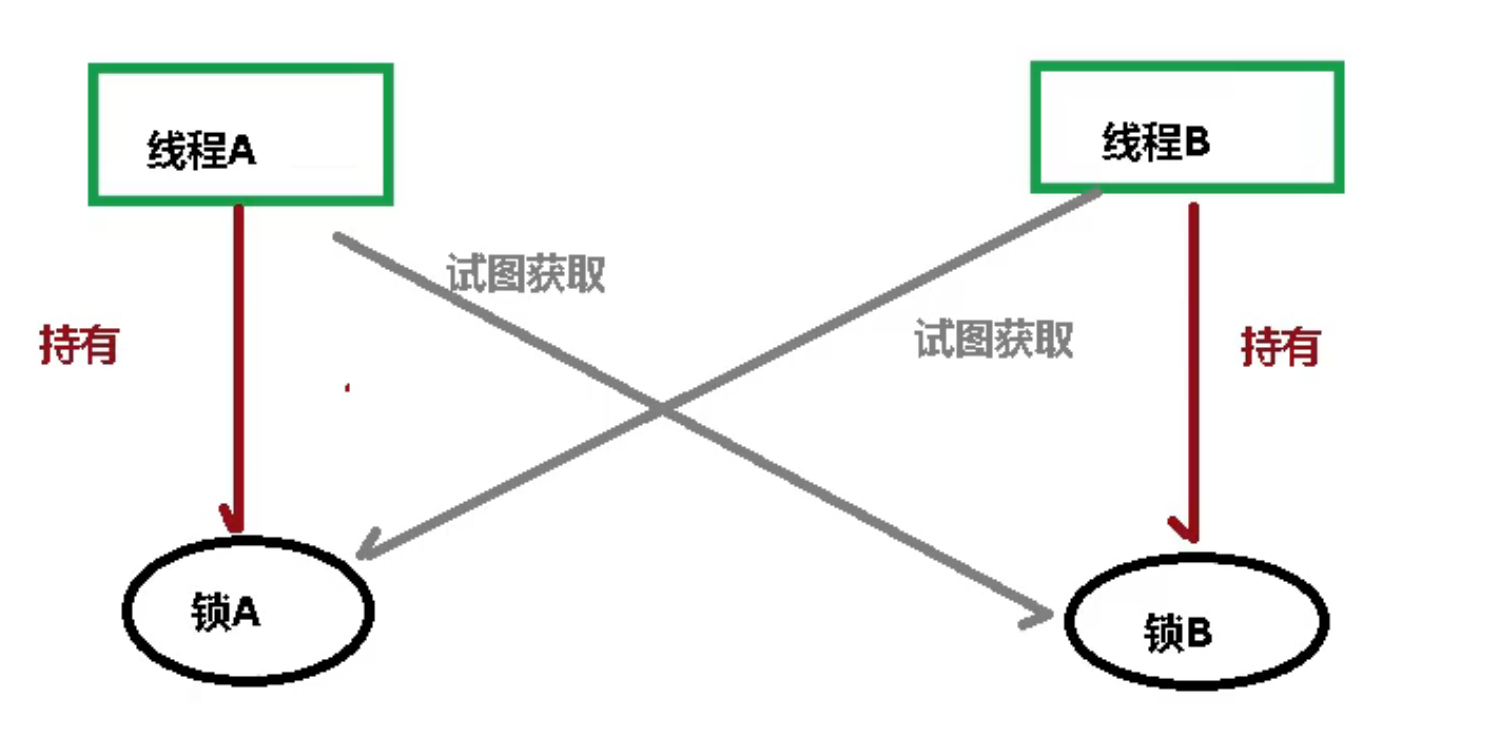Java并发编程
概述
JUC是java.util.concurrent工具包的简称,是处理多线程的工具包
wait方法和sleep方法区别
- wait是Object的方法,任何对象实例都可以调用。sleep是Thread的静态方法
- sleep不会释放锁,它也不需要占用锁。wait会释放锁,但调用它的前提是当前线程占有锁(即代码要在synchronized中)
- 它们都会被interrupted方法中断
管程
Monitor监视器,是一种同步机制,保证在同一时间,只有一个线程访问被保护的数据或者代码
jvm同步基于进入和退出,使用管程对象实现的
用户线程和守护线程
- 用户线程:自定义线程,主线程结束了,用户线程还存活,jvm存活
- 守护线程:比如垃圾回收,没有用户线程了,都是守护线程,jvm结束
1
2
3
4
5
6
7
8
9
10
11
| Thread thread=new Thread(()->{
System.out.println(Thread.currentThread().getName()+":::"+Thread.currentThread().isDaemon());
while(true){
}
});
thread.setDaemon(true);
thread.start();
System.out.println(Thread.currentThread().getName()+"::::主线程结束");
|
Lock接口
1
2
3
4
5
6
7
8
9
10
11
12
13
14
15
16
17
18
19
20
21
22
23
24
25
26
27
28
29
| class Ticket {
private int number = 30;
public synchronized void sale() {
if (number > 0) {
System.out.println(Thread.currentThread().getName() + "买到了::" + (number--) + "票,剩余:" + number);
}
}
}
class LTicket {
private int number = 30;
public final ReentrantLock lock = new ReentrantLock();
public void sale() {
lock.lock();
try {
if (number > 0) {
System.out.println(Thread.currentThread().getName() + "买到了::" + (number--) + " 剩余:" + number);
}
} finally {
lock.unlock();
}
}
}
|
线程间通信
1
2
3
4
5
6
7
8
9
10
11
12
13
14
15
16
17
18
19
20
21
22
23
24
25
26
27
28
29
30
31
32
33
34
35
36
37
38
39
40
41
42
43
44
45
46
47
48
49
50
51
52
53
54
55
56
57
58
59
60
| class T {
private int number = 0;
public synchronized void incr() throws InterruptedException {
while (number != 0) {
this.wait();
}
number++;
System.out.println(Thread.currentThread().getName() + " :: " + number);
this.notifyAll();
}
public `synchronized`
void decr() throws InterruptedException {
while (number != 1) {
this.wait();
}
number--;
System.out.println(Thread.currentThread().getName() + " :: " + number);
this.notifyAll();
}
}
class T2 {
private int number = 0;
private final Lock lock = new ReentrantLock();
private final Condition condition = lock.newCondition();
public void incr() throws InterruptedException {
lock.lock();
try {
while (number != 0) {
condition.await();
}
number++;
System.out.println(Thread.currentThread().getName() + " :: " + number);
condition.signalAll();
} finally {
lock.unlock();
}
}
public void decr() throws InterruptedException {
lock.lock();
try {
while (number != 1) {
condition.await();
}
number--;
System.out.println(Thread.currentThread().getName() + " :: " + number);
condition.signalAll();
} finally {
lock.unlock();
}
}
}
|
线程间定制化通信

1
2
3
4
5
6
7
8
9
10
11
12
13
14
15
16
17
18
19
20
21
22
23
24
25
26
27
28
29
30
31
32
33
34
35
36
37
38
39
40
41
42
43
44
45
46
47
48
49
50
51
52
53
54
55
56
57
58
59
60
61
62
63
64
65
66
67
68
69
70
71
72
73
74
75
76
77
78
79
80
81
82
83
84
85
86
87
88
89
90
91
| class Ticket {
private int flag = 1;
private final Lock lock = new ReentrantLock();
private final Condition c1 = lock.newCondition();
private final Condition c2 = lock.newCondition();
private final Condition c3 = lock.newCondition();
public void print5(int loop) throws InterruptedException {
lock.lock();
try {
while (flag != 1) {
c1.await();
}
for (int i = 1; i <= 5; i++) {
System.out.println(Thread.currentThread().getName() + " :: " + i + " : 轮数:" + loop);
}
flag = 2;
c2.signalAll();
} finally {
lock.unlock();
}
}
public void print10(int loop) throws InterruptedException {
lock.lock();
try {
while (flag != 2) {
c2.await();
}
for (int i = 1; i <= 10; i++) {
System.out.println(Thread.currentThread().getName() + " :: " + i + " : 轮数:" + loop);
}
flag = 3;
c3.signalAll();
} finally {
lock.unlock();
}
}
public void print15(int loop) throws InterruptedException {
lock.lock();
try {
while (flag != 3) {
c3.await();
}
for (int i = 1; i <= 15; i++) {
System.out.println(Thread.currentThread().getName() + " :: " + i + " : 轮数:" + loop);
}
flag = 1;
c1.signalAll();
} finally {
lock.unlock();
}
}
}
public class t1 {
public static void main(String[] args) {
Ticket ticket = new Ticket();
new Thread(() -> {
for (int i = 1; i <= 10; i++) {
try {
ticket.print5(i);
} catch (InterruptedException e) {
e.printStackTrace();
}
}
}, "AA").start();
new Thread(() -> {
for (int i = 1; i <= 10; i++) {
try {
ticket.print10(i);
} catch (InterruptedException e) {
e.printStackTrace();
}
}
}, "BB").start();
new Thread(() -> {
for (int i = 1; i <= 10; i++) {
try {
ticket.print15(i);
} catch (InterruptedException e) {
e.printStackTrace();
}
}
}, "CC").start();
}
}
|
集合的线程安全
ArrayList和CopyOnWriteArrayList
1
2
3
4
5
6
7
8
9
10
11
12
13
14
15
16
17
18
|
List<String> list=new CopyOnWriteArrayList<>();
for(int i=0;i< 30;i++){
new Thread(()->{
list.add(UUID.randomUUID().toString().substring(0,8));
System.out.println(list);
},String.valueOf(i)).start();
}
|
HashSet和CopyOnWriteArraySet
1
2
3
4
5
6
7
8
9
10
11
12
|
Set<String> set=new CopyOnWriteArraySet<>();
for(int i=0;i< 30;i++){
new Thread(()->{
set.add(UUID.randomUUID().toString().substring(0,8));
System.out.println(set);
},String.valueOf(i)).start();
}
|
HashMap和ConcurrentHashMap
1
2
3
4
5
6
7
8
9
10
|
Map<String, Object> map=new ConcurrentHashMap<>();
for(int i=0;i< 30;i++){
new Thread(()->{
map.put(UUID.randomUUID().toString().substring(0,8),UUID.randomUUID().toString().substring(0,8));
System.out.println(map);
},String.valueOf(i)).start();
}
|
多线程锁
synchronized
synchronized实现同步的基础:Java中的每一个对象都可以作为锁
具体表现为:
- 对于普通方法,锁的是
当前实例对象
- 对于静态同步方法,锁的是
当前类的Class对象
- 对于同步方法块,锁的是
synchronized括号里配置的对象
公平锁和非公平锁
- 公平锁效率高,
会出现一个线程执行完所有代码
- 非公平锁效率相对低,
每个线程都有执行代码的机会
1
2
3
4
|
private final Lock lock=new ReentrantLock(true);
private final Lock lock=new ReentrantLock();
|
可重入锁
获取到最外层的锁,内层所有代码都可以执行
synchronized
1
2
3
4
5
6
7
8
9
10
11
12
13
|
Object o = new Object();
new Thread(() -> {
synchronized (o) {
System.out.println("外层");
synchronized (o) {
System.out.println("中层");
synchronized (o) {
System.out.println("内层");
}
}
}
}).start();
|
1
2
3
4
5
6
7
|
public synchronized void add(){
add();
}
new Ticket().add();
|
lock
1
2
3
4
5
6
7
8
9
10
11
12
13
14
15
16
|
Lock lock = new ReentrantLock();
new Thread(() -> {
try {
lock.lock();
System.out.println("外层");
try {
lock.lock();
System.out.println("内层");
} finally {
lock.unlock();
}
} finally {
lock.unlock();
}
}).start();
|
死锁
两个或者两个以上进程在执行过程中,因为争夺资源而造成一种互相等待的现象,如果没有外力干涉,他们无法再执行下去

1
2
3
4
5
6
7
8
9
10
11
12
13
14
15
16
17
18
19
20
21
22
23
24
25
26
27
28
29
30
31
32
|
Object a = new Object();
Object b = new Object();
new Thread(()->{
synchronized (a){
System.out.println("获得锁a");
try {
TimeUnit.SECONDS.sleep(1);
} catch (InterruptedException e) {
e.printStackTrace();
}
synchronized (b){
System.out.println("获得锁b");
}
}
},"A").start();
new Thread(()->{
synchronized (b){
System.out.println("获得锁b");
try {
TimeUnit.SECONDS.sleep(1);
} catch (InterruptedException e) {
e.printStackTrace();
}
synchronized (a){
System.out.println("获得锁a");
}
}
},"A").start();
}
|
产生死锁的原因
- 系统资源不足
- 进程运行推送顺序不合适
- 资源分配不当
Callable接口
创建的线程可以有返回值
Runnable接口和Callable接口
- 是否有返回值
- 是否抛出异常
- 实现方法名称不同,一个是run方法,一个是call方法
1
2
3
4
5
6
| FutureTask<Integer> task = new FutureTask<>(() -> {
return 10;
});
new Thread(task,"AA");
System.out.println(task.get());
|
JUC辅助类
CountDownLatch
CountDownLatch类可以设置一个计数器,然后通过countDown方法来进行减1的操作,使用await方法等待计数器不大于0,然后继续执行await方法之后的语句
1
2
3
4
5
6
7
8
9
10
11
12
13
|
CountDownLatch countDownLatch = new CountDownLatch(6);
for (int i = 0; i < 6; i++) {
new Thread(() -> {
System.out.println(Thread.currentThread().getName() + " 执行完成");
countDownLatch.countDown();
}, String.valueOf(i)).start();
}
countDownLatch.await();
System.out.println("全部执行完成");
|
CyclicBarrier
1
2
3
4
5
6
7
8
9
10
11
12
13
14
15
| CyclicBarrier cyclicBarrier = new CyclicBarrier(6,()->{
System.out.println("当值达到6的时候执行");
});
for (int i = 0; i < 6; i++) {
new Thread(() -> {
try {
System.out.println(Thread.currentThread().getName() + " 执行完成");
cyclicBarrier.await();
} catch (Exception e) {
e.printStackTrace();
}
}, String.valueOf(i)).start();
}
|
Semaphore
1
2
3
4
5
6
7
8
9
10
11
12
13
14
15
16
17
18
19
20
21
|
Semaphore semaphore = new Semaphore(3);
for (int i = 0; i < 6; i++) {
new Thread(() -> {
try {
semaphore.acquire();
System.out.println(Thread.currentThread().getName() + " 抢到车位");
TimeUnit.SECONDS.sleep(new Random().nextInt(5));
System.out.println(Thread.currentThread().getName() + " =======离开车位");
} catch (Exception e) {
e.printStackTrace();
}finally {
semaphore.release();
}
}, String.valueOf(i)).start();
}
|
读写锁
一个资源可以被多个读线程访问,或者可以被一个写线程访问,但是不能同时存在读写线程,读写互斥,读读共享

1
2
3
4
5
6
7
8
9
10
11
12
13
14
15
16
17
18
19
20
21
22
23
24
25
26
27
28
29
30
| public volatile Map<String, Object> map = new HashMap<>();
public ReadWriteLock rwLock = new ReentrantReadWriteLock();
public void put(String key, Object v) throws InterruptedException {
rwLock.writeLock().lock();
try {
System.out.println(Thread.currentThread().getName() + " 正在写 " + key);
TimeUnit.MILLISECONDS.sleep(300);
map.put(key, v);
System.out.println(Thread.currentThread().getName() + " 写完了 " + key);
} finally {
rwLock.writeLock().unlock();
}
}
public void get(String key) throws InterruptedException {
rwLock.readLock().lock();
try {
System.out.println(Thread.currentThread().getName() + " 正在读 " + key);
TimeUnit.MILLISECONDS.sleep(300);
map.get(key);
System.out.println(Thread.currentThread().getName() + " 读完了 " + key);
} finally {
rwLock.readLock().unlock();
}
}
|
JUC阻塞队列
可以使得数据由队列的一端输入,从另一端输出
ArrayBlockingQueue(常用):由数组结构组成的有界阻塞队列,基于数组的阻塞队列实现,在ArrayBlockingQueue内部维护了一个定长的数组,以便缓存队列中的数据对象,除了一个定长数组外,ArrayBlockingQueue内部保存着两个整形变量,分别标识着队列的头部和尾部在数组中的位置LinkedBlockingQueue(常用):由链表结构组成的有界(但大小默认值为integer.MAX_VALUE)阻塞队列DelayQueue:使用优先级队列实现的延迟无界阻塞队列PriorityBlockingQueue:支持优先级排序的无界阻塞队列SynchronousQueue:不存储元素的阻塞队列,也即单个元素的队列LinkedTransferQueue:由链表组成的无界阻塞队列LinkedBlockingDeque:由链表组成的双向阻塞队列
| 方法类型 |
抛出异常 |
特殊值 |
阻塞 |
超时 |
| 插入 |
add(e) |
offer(e) |
put(e) |
offer(e,time,unit) |
| 移除 |
remove() |
poll() |
take() |
poll(time,unit) |
| 检查 |
element() |
peek() |
不可用 |
不可用 |

ThreadPool线程池
- 使用Executors
- 使用new ThreadPoolExecutor
corePoolSize:核心线程数(一直存在);线程池创建好以后就准备就绪的线程数量,用来等待接受异步任务去执行maximumPoolSize:最大线程数量keepAliveTime:存活时间。如果当前线程数量大于最大数量,当线程空闲了存活时间后释放空闲的线程unit:时间单位BlockingQueue<Runnable> workQueue:阻塞队列。如果任务有很多,就会将目前多的任务放在队列里面。只要有线程空闲,就会去队列里面取出新的任务继续执行ThreadFactory threadFactory:线程的创建工厂RejectedExecutionHandler handler:如果队列满了,按照指定的策略拒绝执行任务
1
2
3
4
5
6
7
8
9
10
|
Executors.newFixedThreadPool(10);
Executors.newCachedThreadPool();
Executors.newScheduledThreadPool(10);
Executors.newSingleThreadExecutor();
ThreadFactory namedThreadFactory = new ThreadFactoryBuilder()
.setNameFormat("consumer-queue-thread-%d").build();
ExecutorService service=new ThreadPoolExecutor(10, 100, 25L, TimeUnit.SECONDS,
new LinkedBlockingDeque<>(), namedThreadFactory);
|
CompletableFuture
基本用法
1
2
3
4
5
6
7
8
9
10
11
12
13
14
15
16
17
18
19
20
21
22
23
24
25
26
27
28
29
30
31
32
33
34
|
CompletableFuture.runAsync(()->{
},service);
CompletableFuture.supplyAsync(()->{
return 100;
},service);
CompletableFuture.supplyAsync(()->100)
.whenComplete((res,exc)->{
System.out.println("结果是:"+res);
System.out.println("异常是:"+exc);
})
.exceptionally(t->{
return 10;
});
CompletableFuture.supplyAsync(()->100)
.handle((res,exc)->{
System.out.println("结果是:"+res);
System.out.println("异常是:"+exc);
if(res!=null){
return res;
}
if(exc!=null){
return 0;
}
return 10;
});
|
线程串行化
thenApply()和thenApplyAsync()方法:当一个线程依赖另一个线程时,获取上一个任务返回的结果,并返回当前任务的返回值thenAccept()和thenAcceptAsync()方法:消费处理结果。接收任务的处理结果,并消费处理,无返回结果thenRun()和thenRunAsync()方法:带有Async默认是异步执行的,不接收上一个任务返回值
1
2
3
4
5
6
7
8
9
10
11
12
| ExecutorService service=Executors.newSingleThreadExecutor();
CompletableFuture.supplyAsync(()->100)
.thenAccept(res->{
System.out.println("上一个任务的返回值:"+res);
})
.thenApplyAsync(res->{
System.out.println("上一个任务的返回值:"+res);
return 100;
},service)
.thenRunAsync(()->{
System.out.println("无法接收返回值");
},service);
|
两任务组合-都要完成
thenCombine()和thenCombineAsync():组合两个future,获取两个future的返回结果,并返回当前任务的返回值thenAcceptBoth()和thenAcceptBothAsync():组合两个future,获取两个future的返回结果,没有返回值runAfterBoth()和runAfterBothAsync():组合两个future,不需要获取future的结果,只需两个future处理完任务后,处理该任务
1
2
3
4
5
6
7
8
9
10
11
12
13
14
15
16
17
18
19
20
21
22
23
24
25
26
| CompletableFuture<Integer> future01=CompletableFuture.supplyAsync(()->{
int i=10;
return i/2;
},service);
CompletableFuture<Integer> future02=CompletableFuture.supplyAsync(()->{
int i=20;
return i/2;
},service);
future01.runAfterBothAsync(future02,()->{
System.out.println("任务1和任务2执行后执行");
},service);
future01.thenAcceptBothAsync(future02,(res01,res02)->{
System.out.println("任务1返回结果:"+res01);
System.out.println("任务2返回结果:"+res02);
},service);
future01.thenCombineAsync(future02,(res01,res02)->{
System.out.println("任务1返回结果:"+res01);
System.out.println("任务2返回结果:"+res02);
return"任务3自己的返回值";
},service);
|
两任务组合-一个完成
applyToEither()和applyToEitherAsync():两个任务有一个执行完成,获取它的返回值,处理任务并有新的返回值acceptEither()和acceptEitherAsync():两个任务有一个执行完成,获取它的返回值,处理任务,没有新的返回值runAfterEither()和runAfterEitherAsync():两个任务有一个执行完成,不需要获取future的结果,处理任务,没有返回值
1
2
3
4
5
6
7
8
9
10
11
12
13
14
15
16
17
18
19
20
21
22
23
| CompletableFuture<Integer> future01=CompletableFuture.supplyAsync(()->{
int i=10;
return i/2;
},service);
CompletableFuture<Integer> future02=CompletableFuture.supplyAsync(()->{
int i=20;
return i/2;
},service);
future01.runAfterEitherAsync(future02,()->{
},service);
future01.acceptEitherAsync(future02,res->{
System.out.println("任务返回结果:"+res);
},service);
future01.applyToEitherAsync(future02,res->{
System.out.println("任务返回结果:"+res);
return res+1;
},service);
|
多任务组合
allOf():等待所有任务完成anyOf():只要有一个任务完成
1
2
3
4
5
6
7
8
9
10
11
12
13
14
15
16
| CompletableFuture<Integer> future01=CompletableFuture.supplyAsync(()->{
int i=10;
return i/2;
},service);
CompletableFuture<Integer> future02=CompletableFuture.supplyAsync(()->{
int i=20;
return i/2;
},service);
CompletableFuture<Void> allOf=CompletableFuture.allOf(future01,future02);
allOf.get();
CompletableFuture<Object> anyOf=CompletableFuture.anyOf(future01,future02);
anyOf.get();
|
相关文章
JAVA基础
JDBC
JAVA多线程






